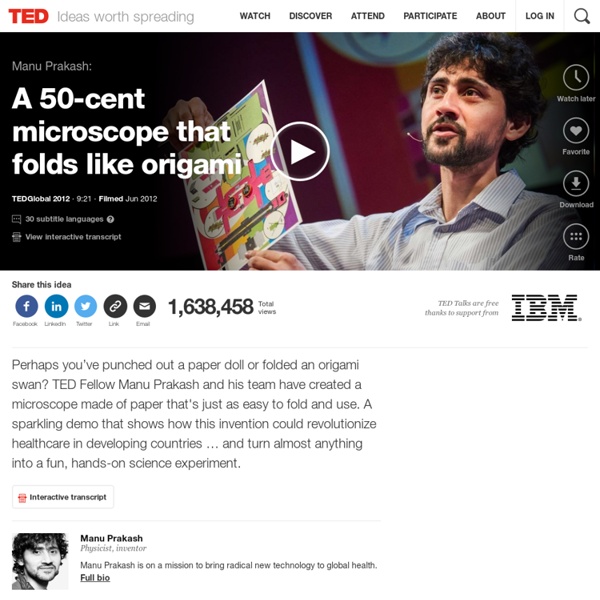



Blog by JoAnn Delaney, MSE BED - DoMoreEdu After collaborating with other tech savvy peers, Google Docs seemed like the best fit for my paperless classroom goal. Students were given accounts and able to sign-in and I led the students through a series of steps to get their virtual science notebooks set up. The students created folders for each subject area they have throughout the school day. In the science folder, they are directed to create a new document for each science unit of study.
The 10 most popular TED-Ed lessons so far Culture A look at OKCupid’s algorithm: Getting personal with TED-Ed for Valentine’s Day How, exactly, does online dating work? In this perfect-for-Valentine’s-Day TED-Ed lesson, OKCupid co-founder Christian Rudder walks you through how the dating website does its matching — by using a carefully-honed algorithm to create a compatibility rating for two potential daters. In this fascinating video, Rudder shares how the site lets daters decide which factors are […] Health Seeds for healthy cells, candy for cancer: The stop motion tricks behind this TED-Ed lesson Making this TED-Ed video required (a) a lot of knitting and (b) a ton of boxes of Nerds. 5 rules for productive conflict Rob Manning did everything in his power to screw up the Curiosity rover’s landing on Mars last night. Manning not only cut radio signals to the Jet Propulsion Laboratory’s control room, but also simulated a hole being poked in the rover’s fuel system and solar flares flying toward the spacecraft. Why would he do this? Because he is the chief engineer for the rover mission, and wanted his team to be able to handle any worst-case scenario. “Being a gremlin allows me to soul-search and look at all the things that I missed,” Manning told the Chicago Tribune in the days before last night’s landing. Manning’s mischief would certainly get a thumbs up from management expert Margaret Heffernan. To make her point, Heffernan shared the story of Alice Stewart, an epidemiologist in England in the 1950s, who studied a steep uptick in the incidence of childhood cancer. 1. 2. 5. Explains Heffernan, “All of these guidelines are neutral and designed to aid exploration rather than judgment.
Coin » Frequently Asked Questions Q. What is a Coin? A. Coin is a connected device that can hold and behave like the cards you already carry. Coin works with your debit cards, credit cards, gift cards, loyalty cards and membership cards. Q. A. Q. A. Q. A. Q. A. Q. A. Q. A. U.S. Customers located outside of the U.S.: Coin does not support chip & pin (EMV) yet. Q. A. Q. A. Q. A. Q. A. Q. A. Q. A. Q. A. Q. A. Q. A. Q. A. Q. A. Q. A. Q. A. Q. A. Q. The University of Oklahoma College of Law: A Chronology of US Historical Documents Links marked with an asterisk (*) are to other websites and will open in a new window. Pre-Colonial To 1600 The Magna Carta (1215) Letter from Christopher Columbus to the King & Queen of Spain (1490's) The *Iroquois Constitution 17th Century 18th Century The Albany Plan of 1754 The Resolutions of the Stamp Act (Oct. 19, 1765) 19th Century First Inaugural Address of President Thomas Jefferson (1801) Second Inaugural Address of President Thomas Jefferson (1805) The *Thomas Jefferson Papers at the Library of Congress *Thomas Jefferson Online Resources at the University of Virginia Information on *Monticello First Inaugural Address of President James Madison (1809) Second Inaugural Address of President James Madison (1813) The text of the Star Spangled Banner (Sept. 20, 1814) First Inaugural Address of President James Monroe (1817) Second Inaugural Address of President James Monroe (1821) The Monroe Doctrine (Dec. 2, 1823) Inaugural Address of President *Rutherford B.
5 charlas de TED para inspirar a los maestros de la nueva eraYoung Marketing En los modelos de educación tradicionales el profesor expone el contenido académico ya establecido sin brindar la posibilidad de que los estudiantes decidan qué ni cómo aprender. Con la llegada de nuevas metodologías, ésto ha cambiado. Los profesores se están convirtiendo en guías y observadores de los procesos de aprendizaje, quienes fomentan la autonomía y la colaboración en sus estudiantes. Aquí les mostramos cinco conferencias de TED que pueden inspirar a la nueva generación de educadores, quienes tienen la misión de convertirse en modelos a seguir, crear un ambiente de aprendizaje óptimo y desarrollar en sus estudiantes las habilidades del siglo XXI. 1. Ken Robinson es un asesor educativo, quien se ha enfocado en investigar la importancia de la creatividad en los sistemas de aprendizaje. 2. En ocasiones la música, en este caso el hip-hop, puede ser utilizada como una herramienta pedagógica para formar mejores maestros. 3. 4. Rita F. 5. Imagen: TED También puede interesarte:
Paper Generators: Harvesting Energy from Touching, Rubbing and Sliding Disney Research, Pittsburgh We present a new energy harvesting technology that generates electrical energy from a user’s interactions with paper-like materials. The energy harvesters are flexible, light, and inexpensive, and they utilize a user’s gestures such as tapping, touching, rubbing and sliding to generate energy. Research Paper Paper Generators: Harvesting Energy from Touching, Rubbing and Sliding Karagozler, M. Technical Details Paper Generators are based on electrets: materials that hold quasi-permanent electric charge. The operation of the Paper Generators relies on the movement of the two conductive sheets relative to each other and the electret, PTFE. The same principle of operation applies to the horizontal movement of the top electrode (sliding). Team and Credits The Paper Generators project is being developed at Disney Research Pittsburgh by M. Contact Email: emre.karagozler [at] disneyresearch [dot] com Gallery An image of a light bulb is patterned on the e-paper display.
Exploratorium: the museum of science, art and human perception